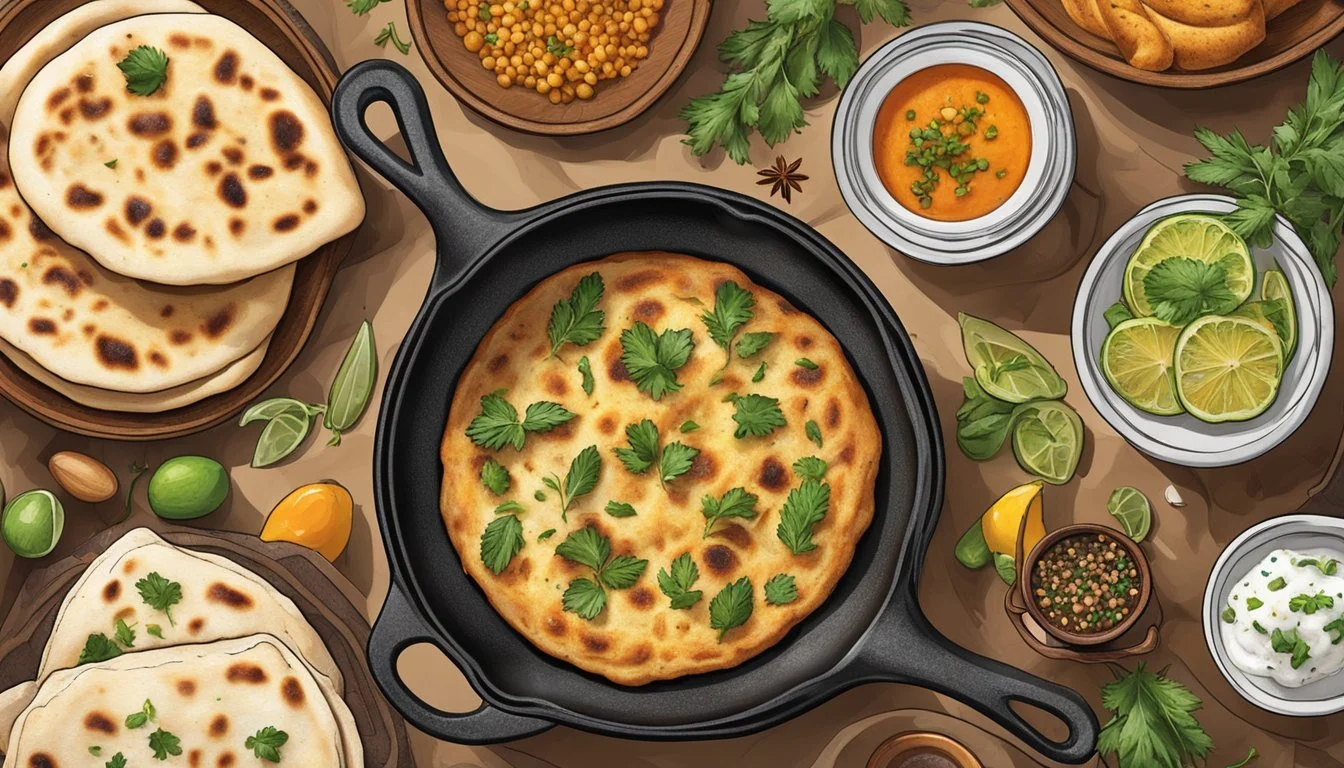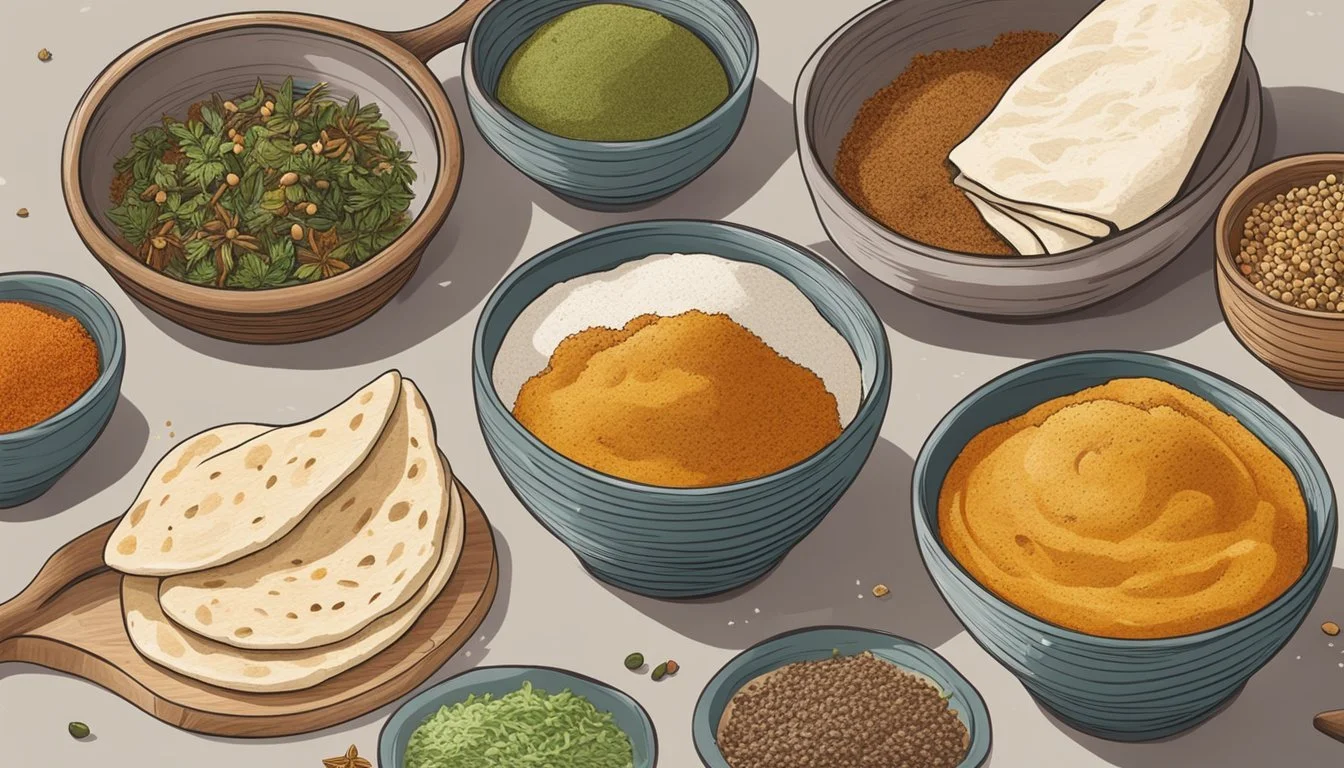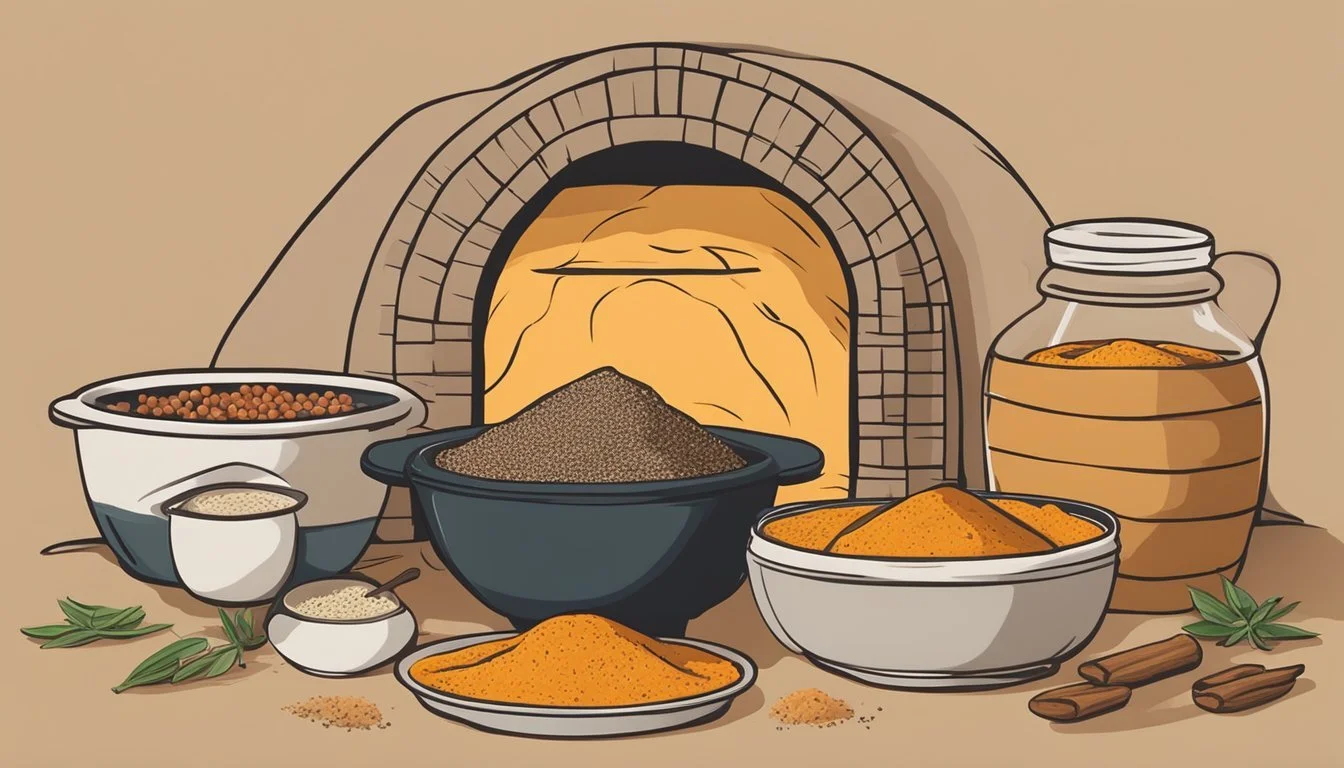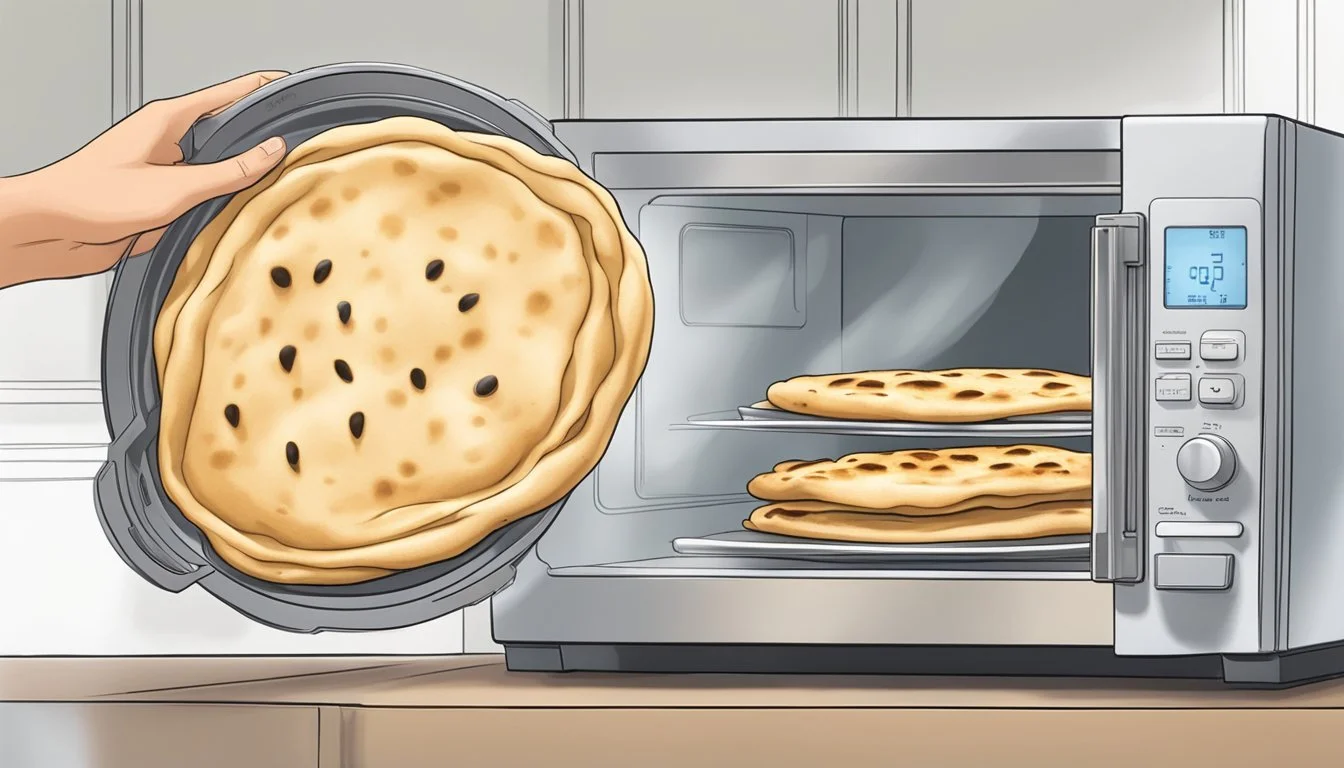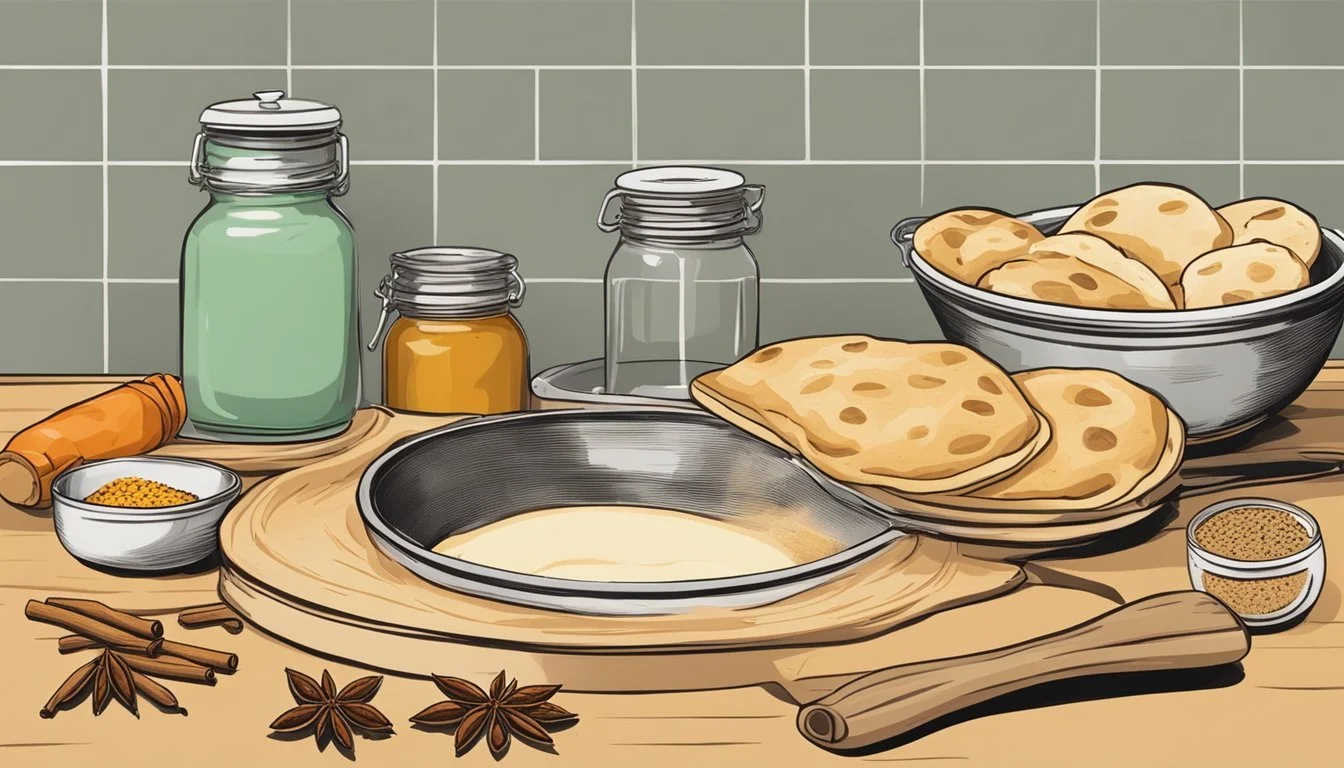Sourdough Naan
An Indian Culinary Adventure in Home Baking
Sourdough naan is a unique twist on the traditional Indian flatbread (What wine goes well with bread?), incorporating the tangy flavors of sourdough to bring a new dimension to familiar South Asian cuisine. Utilizing the natural fermentation of sourdough discard, this naan variety not only offers a more complex taste profile but also taps into the growing interest in fermentation and its benefits. Sourdough naan pairs the subtle sourness of the starter with the soft texture and mild flavors typical of naan bread, making it an excellent accompaniment to a variety of Indian dishes or a flavorful base for wraps and sandwiches.
The process of making sourdough naan involves combining the active ingredients of sourdough starter with pantry staples like flour, baking powder, and salt, along with dairy products such as milk and yogurt to achieve the desired softness and richness. The fermentation period is key to developing the bread's characteristic flavor and texture. Whether the dough is allowed to rest at room temperature for a few hours or given a shorter rest, the artisanal approach to sourdough naan makes it a rewarding endeavor for both novice and experienced bakers.
As more home cooks seek to infuse their meals with inventive flavors and handmade touches, sourdough naan serves as a perfect example of how traditional techniques can be adapted to contemporary kitchens. The bread's versatility and the satisfaction of creating it from scratch can transform the everyday dining experience into a culinary exploration, making sourdough naan not just a dish, but a journey into the art of bread making.
The Basics of Sourdough Naan
Sourdough naan combines the tangy flavors of traditional sourdough with the soft, pillowy texture of an Indian staple. Mastery of sourdough starter and a handful of key ingredients are fundamental to creating authentic sourdough naan at home.
Understanding Sourdough Starter
A sourdough starter is a fermented mixture of flour and water that contains a colony of microorganisms, including wild yeast and lactobacilli. The starter is the heart of any sourdough recipe, providing the unique tangy flavor and natural leavening properties important for the dough to rise. For sourdough naan, a starter should be well-maintained, active, and bubbly. Consistency in feeding the starter is crucial to keep it vigorous for imparting the right flavors and leavening the naan effectively.
Essential Ingredients for Sourdough Naan
Creating sourdough naan requires the following essential ingredients:
Flour: All-purpose flour serves as the structural base of the naan.
Sourdough Starter: A portion of active, fermented dough that introduces natural yeast and bacteria.
Milk and Yogurt: These dairy products add moisture and richness to the dough, and aid in tenderizing the gluten.
Salt: Enhances flavor and controls yeast activity.
Sugar: Provides a touch of sweetness and helps with yeast fermentation.
Baking Soda: A small amount can be used to support the rise and browning of the naan.
Each ingredient has a specific role and must be combined with basic techniques such as kneading and allowing the dough to properly ferment and rise. This ensures the naan develops the desired texture and flavor nuances. Typically, sourdough naan dough rests at room temperature, which may vary between 2 to 4 hours, to allow the starter to ferment the dough and impart its characteristic sour flavor. After resting, the dough is divided, shaped, and often cooked in a hot skillet to replicate the effect of a traditional tandoor oven. The naan may be brushed with melted butter for a finishing touch before serving.
Preparing the Dough
The creation of sourdough naan involves a series of steps designed to mix, knead, and allow the dough to rise properly, each crucial for achieving the perfect texture and flavor.
Mixing and Resting
To begin, one combines all-purpose flour and whole wheat flour with the sourdough discard, which acts as a natural leavening agent. Alongside the flours, ingredients like water, milk, and yogurt are included to add moisture and aid the fermentation process. This mixture is stirred until a cohesive dough forms and then left to rest. The resting period is essential, allowing the gluten networks to develop, which can take anywhere from 30 minutes to 4 hours, contributing to the dough's elasticity and ability to trap gas, thus creating the characteristic bubbles and texture in the final product.
Prep Time: 30 minutes to 4 hours
Kneading Techniques
After the initial resting period, kneading begins. One can use a stand mixer with a hook attachment for a uniform and less labor-intensive process, or one can opt for hand kneading on a lightly floured work surface. This step is pivotal to work the dough until it becomes smooth and passes the windowpane test, indicating that the gluten structure is well-developed.
Kneading: 8-10 minutes with mixer or by hand
The Importance of Rise Time
Once kneaded, the dough must undergo a final rise, often referred to as proofing. This stage is crucial as it allows the sourdough culture to ferment the dough further, creating the light and airy texture synonymous with naan. The rise time varies but should continue until the dough has visible bubbles on the surface and has roughly doubled in size. Depending on temperature and the activity level of the sourdough discard, this could take an additional 2 to 3 hours.
Total Time (including rise time): 2.5 to 7 hours, depending on conditions
The result should be a pliable and puffed dough ready for shaping and cooking, promising the authentic taste and texture of traditional sourdough naan.
Cooking Methods
Crafting the perfect Sourdough Naan requires a mastery of heat and timing, whether utilizing traditional cookware or alternative cooking surfaces. The goal is to achieve a balance between a crispy exterior and a soft, airy interior.
Using a Cast Iron Skillet
A cast iron skillet is an ideal substitute for a tandoor oven. It retains heat efficiently, distributing it evenly across the flatbread's surface. To cook naan bread in a skillet, preheat it over medium to high heat. Once the skillet is hot, place the rolled dough onto the surface, cooking for 2 minutes until bubbles form. Flip the naan and cook for an additional 1-2 minutes on the other side until it puffs up. The high consistent heat mimics the traditional tandoor environment.
Alternative Cooking Surfaces
Griddle or Frying Pan: Similar to the skillet method, a griddle or frying pan should be heated until hot before adding the dough. Cook times may vary slightly.
Oven: For those seeking an oven-baked option, preheat the oven to its highest setting, place the dough on a preheated, ideal cast iron griddle, and bake for 1-2 minutes each side, watching for the naan to puff.
Note: Regardless of the surface, the key to successful naan lies in monitoring the heat and cook time to create a delightful, blistered texture while maintaining the bread's inherent softness.
Flavor Profiles and Variations
Sourdough naan presents an opportunity to experiment with a variety of flavors that can either elevate the traditional taste or offer a new twist on this classic Indian bread. By introducing different ingredients such as herbs, spices, and cheeses, one can customize the flavor profile to suit individual palates or complement specific dishes.
Enhancing with Butter and Garlic
Incorporating melted butter and garlic into sourdough naan can transform it into a rich and savory experience. A popular variation is garlic cilantro naan, which combines roasted garlic with chopped cilantro, brushed on top of the naan before baking. This melds the pungent aroma of garlic with the fresh, citrusy notes of cilantro, creating a flavor that is both comforting and refreshing.
Butter: Brush naan with melted butter immediately after baking for a soft, rich finish.
Garlic: Add minced or roasted garlic into the dough or brush it on top for a pronounced garlic flavor.
Incorporating Herbs and Spices
Sourdough naan's neutral base perfectly complements the introduction of various herbs and spices. Traditional flavors are often achieved through the use of nigella seeds or kalonji, which are sprinkled on top of the naan before baking. These small black seeds offer a slight nuttiness with an herbal bitterness that deepens the complexity of the naan.
Cilantro: Fresh cilantro leaves can be kneaded into the dough or sprinkled on top before baking.
Nigella seeds: These seeds add both texture and a unique peppery flavor.
Cheese and Other Add-Ins
Cheese like paneer or even popular varieties like mozzarella can be incorporated into the dough to produce a cheese sourdough naan. For a sweeter take, consider adding raisins or nuts, creating a contrast that plays against the tangy sourdough base. Another savory option includes onion naan, where finely chopped onions are introduced into the dough for a subtle sweetness and additional texture.
Cheese: Fold cubes or shredded cheese into the dough for a melty, gooey filling.
Raisins/Nuts: Incorporate into the dough for a sweet, textural contrast.
By understanding these variations, home bakers can confidently craft their own sourdough naan that pays homage to traditional Indian flavors or ventures into new culinary territories.
Nutritional Considerations
Sourdough naan, a twist on the traditional Indian flatbread, offers unique nutritional aspects from both its fermentation process and ingredient composition. Understanding its calorie content and nutritional makeup, alongside considerations for those with specific dietary needs such as gluten sensitivity, are important for incorporating sourdough naan into a healthy eating plan.
Calorie and Nutrition Breakdown
The calorie content and nutritional value of sourdough naan can vary based on the specific recipe and size of the naan. Generally, one serving of sourdough naan contains around 200-300 calories. The primary ingredients, such as bread flour or all-purpose flour, contribute the bulk of these calories in the form of carbohydrates. A standard recipe may also incorporate milk, yogurt, and sourdough starter, which can add protein and dietary fiber to the overall nutrition profile.
The fermentation process of the sourdough may also have a positive impact on health by enhancing digestibility and potentially improving the bread's nutritional content. Here's a basic breakdown of the nutrition one might expect per serving:
Calories: 200-300
Carbohydrates: 30-50g
Proteins: 6-8g
Fats: 3-5g
Dietary Fiber: 2-4g
Gluten Content and Alternatives
Standard sourdough naan is made with wheat-based flours like bread flour or all-purpose flour, which contain gluten. Individuals with celiac disease or gluten sensitivity must avoid these ingredients to prevent adverse health effects. For those who wish to enjoy sourdough naan but cannot consume gluten, alternative flours such as gluten-free all-purpose flour, almond flour, or buckwheat flour can be used.
These alternative flours will alter the texture and flavor of the naan, and adjustments to the recipe—such as xanthan gum or other binders—might be necessary to achieve a desirable result. Here are options for gluten-free flours that can be considered:
Almond Flour: Rich in protein and dietary fiber but can lead to denser naan.
Buckwheat Flour: Gluten-free and rich in nutrients, offering a robust flavor.
Gluten-free All-Purpose Flour: A blend designed to mimic the properties of wheat flour.
When using alternative flours, the calorie count may differ, and they often provide a different array of vitamins and minerals compared to traditional flours, contributing to a varied nutritional profile.
Serving and Pairing Suggestions
Sourdough naan, a delightful twist on traditional Indian flatbread, can be the star of a meal or play a supporting role. When introducing this versatile bread to any dining experience, its implications go far past its use as a simple wrap or sandwich base.
Going Beyond the Traditional Wrap
Sourdough naan can serve as a unique foundation for various toppings, much like a pizza base. One can top sourdough naan with ingredients like roasted vegetables, spiced meats, or a blend of cheeses before placing it under the broiler to create a quick and flavorful flatbread meal. Pairing sourdough naan with chutneys or pickles accentuates its flavors and adds a zing to each serving.
Soups and Stews
For soups and stews, sourdough naan becomes an excellent vessel for dipping and savoring the rich broths. Its tangy note and sturdy texture make it a prime candidate for absorbing flavors without disintegrating immediately. Whether one is enjoying a hearty lentil stew or a light vegetable soup, a side of sourdough naan can enhance the experience, ensuring that none of the delicious, spiced liquid goes to waste.
Storing and Reheating
Proper storage extends the shelf life of sourdough naan, and understanding the optimal reheating method ensures it retains its flavor and texture when it's time to enjoy.
Refrigeration and Freezing Tips
Refrigeration: For short-term storage, one should place sourdough naan in an airtight container or wrap it tightly with plastic wrap to keep it fresh. The naan can be stored in the fridge for up to 5 days.
Freezing: For long-term storage, freezing is the best option. To freeze sourdough naan, wrap each piece individually in cling film and then place them in a freezer-safe bag. Label the bag with the date to keep track of how long they've been stored. Sourdough naan can be frozen for up to 3 months.
Best Practices for Reheating
In the Oven: Preheat your oven to 350°F. Wrap the sourdough naan in aluminum foil to prevent it from drying out. Place the wrapped naan on a baking tray and heat for approximately 10-15 minutes or until warm.
In the Microwave: For a quicker option, one can use the microwave. Lightly dampen a paper towel, wrap it around the sourdough naan, and microwave on high for 30 seconds to 1 minute. The moisture from the towel helps to prevent the naan from drying out.
In the Air Fryer: When using an air fryer, it's important to first preheat the device to 400°F. Spritz the sourdough naan lightly with olive oil for improved texture. Place the naan in the air fryer basket, being careful not to overcrowd it, and heat for around 3 minutes or until warm throughout.
Advanced Sourdough Naan Techniques
Mastering advanced techniques in crafting sourdough naan can elevate one's baking skill substantially. This section delves into creating the quintessential oval shape and achieving the signature browned and bubbly texture that distinguishes an expertly made naan.
Creating the Perfect Oval Shape
The ideal oval shape of sourdough naan is achieved through a combination of rolling and hand shaping. Here's a step-by-step approach:
Roll the Dough: Place a piece of the rested dough on a lightly floured surface. Using a rolling pin, roll the dough into an oval that is approximately 1/4-inch thick, ensuring even thickness throughout.
Refine the Shape: Use your hands to gently stretch the longer sides of the oval to accentuate the shape. It should resemble an elongated teardrop, a characteristic shape for naan.
Achieving Browned and Bubbly Texture
The hallmark of a well-cooked sourdough naan is the presence of bubbles and brown spots which contribute to its texture and flavor.
Temperature Control: Cook the naan in a very hot, preferably cast-iron skillet or a traditional tandoor. The high heat encourages the formation of steam within the dough, creating the desired bubbles.
Time Management: Each side of the naan should be cooked for 1-2 minutes. Watch for the surface to bubble and the underside to develop golden brown spots before flipping.
In both processes, precise craftsmanship is key to achieving consistency and quality in sourdough naan, giving it the authentic characteristics appreciated in Indian culinary traditions.
The History of Naan
Naan is a leavened, oven-baked flatbread found in the cuisines of Central and South Asia. The roots of naan can be traced to the influence of Persian culture. During the early 16th century, the Mughals, led by Babur, brought this cuisine feature into the Indian subcontinent. Over time, Indian cooks adapted the bread, infusing it with local flavors.
Traditionally, naan is cooked in a tandoor oven. This cylindrical clay oven enhances the distinct texture and flavor of the bread. The precise origin is often associated with legend and lore. Amir Khusrow, a poet of the Delhi Sultanate era, mentioned naan-e-tanuk (light bread) and naan-e-tanuri (cooked in a tandoor oven) in his scripts around 1300 A.D.
Historically, this type of bread was a delicacy. Due to its time-consuming preparation, it was typically reserved for the royalty of the Mughal courts in the 1500s.
Here's a brief timeline that outlines the history of naan:
1300s: Amir Khusrow documents naan in India.
1500s: Becomes popular among Mughal nobility.
1799: The word 'naan' enters the English language documented by William Tooke.
Modern Day: Naan has become a global phenomenon, commonly found in Indian restaurants worldwide.
In modern culinarity, the flatbread has evolved beyond its roots, now encompassing a variety of ingredients and preparation styles, often served as a side to popular dishes like kebabs or curry. Naan continues to be a beloved element of Indian cuisine, representing a culinary blend of history and flavor.
Conclusion
Sourdough naan emerges as a creative twist on traditional Indian cuisine, blending the tangy depth of sourdough with the soft, chewy texture characteristic of naan. Home cooks have found that merging these methods results in a flatbread that is both flavorful and satisfying.
The preparation of sourdough naan involves mixing ingredients such as flour, milk, yogurt, and sourdough discard to create a dough that is then allowed to rest. Different recipes may vary the resting time from 30 minutes to several hours, impacting the flavor's complexity and depth. Cooking this fusion bread typically uses a hot skillet, and the dough's transformation, evidenced by air pockets and a golden-brown surface, signifies completion.
For those interested in adding a unique touch to their culinary repertoire, sourdough naan can serve as an excellent starting point. It represents a harmonious balance between traditional techniques and modern innovation.
Key Considerations:
Resting Time: Impacts flavor development; ranges from 30 minutes to several hours.
Cooking Method: Usually in a skillet, watching for the classic puff and golden-brown exterior.
Consistency: Achieving a soft, chewy inside and a slightly crisp exterior is crucial.
In crafting sourdough naan, attention to detail and patience are important. Those experimenting with this bread are encouraged to personalize their recipes according to taste preferences and desired sourdough characteristics.

